NSTA’s K–College Science Education Journals: November 2014 Issues Online
By Lauren Jonas, NSTA Assistant Executive Director
Posted on 2014-11-14
Cause and effect, solutions to problems, analyzing and interpreting data, and quantitative reasoning… these are the subjects science teachers are writing about in this month’s K-College journals from NSTA. The November issues are online, in members’ mailboxes, and ready to inspire teachers!
Science and Children
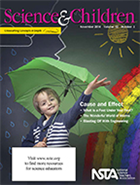 No matter the age at which you introduce cause and effect, it must be consciously developed and repeated frequently. The resources in this issue of S&C will help your students extend their understanding of this essential crosscutting concept.
No matter the age at which you introduce cause and effect, it must be consciously developed and repeated frequently. The resources in this issue of S&C will help your students extend their understanding of this essential crosscutting concept.
Featured articles (please note, only those marked “free” are available to nonmembers without a fee):
- Free – Editor’s Note: Cause and Effect
- Real-World Units in the Conceptual Age
- STEM in a Hair Accessory
- Free – The Wonderful World of Worms
- What Is a Foot Under Your Feet?
- Full Table of Contents
Science Scope
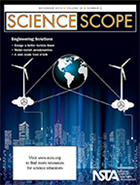 Science and engineering can offer solutions to many of today’s most challenging problems. In this issue, we explore a number of STEM-based activities that will help turn your students into the problem solvers of tomorrow.
Science and engineering can offer solutions to many of today’s most challenging problems. In this issue, we explore a number of STEM-based activities that will help turn your students into the problem solvers of tomorrow.
Featured articles (please note, only those marked “free” are available to nonmembers without a fee):
- Construct, Critique, and Connect: Engineering as a Vehicle to Learn Science
- Designing Earthquake-Resistant Structures: Integrating Science and Engineering Practices
- Free – Editor’s Roundtable: EQuIP—A Tool to Help Keep the NGSS on Course
- Free – Engineering Design and EFFECTs: A Water Filtration Example
- Redesigning the Water Rocket: An Engineering-Design Cycle for Integrating Science and Engineering Practices and Nature of Science Learning
- Saving Pelicans: A STEM Integration Unit
- The Justin Time Challenge
- Full Table of Contents
The Science Teacher
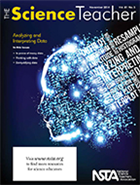 Our world is awash in a sea of data. We encounter more data on a daily basis than ever before, conveying information about weather, health, politics, finance, and science. Data arrives via sensors, social media, digital photos, weather stations, and many other sources. As our ability to store and share data increases exponentially, our students must develop the skills and habits of mind necessary to analyze and interpret information. The Next Generation Science Standards recognize Analyzing and Interpreting Data as one of the eight essential practices of science and engineering. This issue offers ideas for including this important practice in your own teaching.
Our world is awash in a sea of data. We encounter more data on a daily basis than ever before, conveying information about weather, health, politics, finance, and science. Data arrives via sensors, social media, digital photos, weather stations, and many other sources. As our ability to store and share data increases exponentially, our students must develop the skills and habits of mind necessary to analyze and interpret information. The Next Generation Science Standards recognize Analyzing and Interpreting Data as one of the eight essential practices of science and engineering. This issue offers ideas for including this important practice in your own teaching.
Featured articles (please note, only those marked “free” are available to nonmembers without a fee):
- Demystifying Data
- Free – Editor’s Corner: Analyzing and Interpreting Data
- Free – In Praise of Messy Data
- Reflecting on Data
- The Graph Choice Chart
- The Green Room: The Deadliest Infectious Diseases
- Thinking With Data
- Full Table of Contents
Journal of College Science Teaching
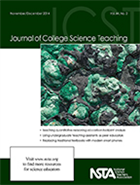 Read about a laboratory exercise (the calculation of an individual’s own carbon footprint) designed to teach quantitative reasoning in the context of authentic problems that are relevant to students’ lives. Find out how one group of authors made their undergraduate atmospheric science classes more student centered and collaborative through the implementation of high-altitude balloon research. Don’t miss the article about an ecology course in which textbooks were eliminated and students were allowed to learn science using their cell phones in place of textbooks. Find all this and more in this month’s issue of JCST.
Read about a laboratory exercise (the calculation of an individual’s own carbon footprint) designed to teach quantitative reasoning in the context of authentic problems that are relevant to students’ lives. Find out how one group of authors made their undergraduate atmospheric science classes more student centered and collaborative through the implementation of high-altitude balloon research. Don’t miss the article about an ecology course in which textbooks were eliminated and students were allowed to learn science using their cell phones in place of textbooks. Find all this and more in this month’s issue of JCST.
Featured articles (please note, only those marked “free” are available to nonmembers without a fee):
- Active Learning in the Atmospheric Science Classroom and Beyond Through High-Altitude Ballooning
- Eliminating the Textbook: Learning Science With Cell Phones
- Point of View: Why Students Should Listen
- Research and Teaching: Midterm and First-Exam Grades Predict Final Grades in Biology Courses
- Research and Teaching: Statistics Across the Curriculum Using an Iterative, Interactive Approach in an Inquiry-Based Lab Sequence
- Research and Teaching: Undergraduate Science Learners Show Comparable Outcomes Whether Taught by Undergraduate or Graduate Teaching Assistants
- Free – Teaching Quantitative Reasoning for Nonscience Majors Through Carbon Footprint Analysis
- Too Long to Read: Assessing the Motivation Behind Graduate Student Attendance in Reading Groups
- Using Collaboration Between English and Biology to Teach Scientific Writing and Communication
- Full Table of Contents
Get these journals in your mailbox as well as your inbox—become an NSTA member!
The mission of NSTA is to promote excellence and innovation in science teaching and learning for all.
Follow NSTA
| |
|
|
|
Cause and effect, solutions to problems, analyzing and interpreting data, and quantitative reasoning… these are the subjects science teachers are writing about in this month’s K-College journals from NSTA. The November issues are online, in members’ mailboxes, and ready to inspire teachers!
Learn to engage students in scientific argumentation
By Claire Reinburg
Posted on 2014-11-14
In his popular workshops at last week’s NSTA conference in Orlando, Victor Sampson presented tips and strategies for engaging students in scientific argumentation, a key practice of science that helps students master content while they write about and discuss claims and evidence. This month’s Book Beat features classroom activities designed to foster students’ ability to analyze data, construct arguments, and learn to support claims with evidence.
Discussion and Argumentation in the Science Classroom
The goals of science education today include helping students not only understand important concepts but also learn to do science. The Next Generation Science Standards emphasize that students need to understand disciplinary core ideas, be aware of seven crosscutting concepts that span the disciplines of science, and learn how to participate in eight key scientific practices to be proficient in science. One increasingly popular way to knit all these elements together is argument-driven inquiry, an innovative approach to lab instruction and the focus of a growing series of books by Victor Sampson and his colleagues. The just-published Argument-Driven Inquiry in Chemistry: Lab Investigations for Grades 9–12 is an engaging approach to lab instruction that brings together content, crosscutting concepts, and scientific practices to make labs more authentic and educative for students.The authors place emphasis throughout the book on argumentation—the process of proposing, supporting, evaluating, and refining claims—which the National Research Council advocates using more in today’s 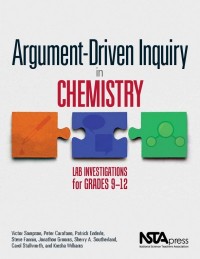 science classes. Download the free lab “Characteristics of Acids and Bases: How Can the Chemical Properties of an Aqueous Solution Be Used to Identify It as an Acid or a Base?”, which gives students an opportunity to devise, test, and refine a method that can be used to classify an aqueous solution as being an acid or a base using the physical or chemical properties of the solution. Students will also learn about the difference between observations and inferences in science and the different methods used in scientific investigations.
science classes. Download the free lab “Characteristics of Acids and Bases: How Can the Chemical Properties of an Aqueous Solution Be Used to Identify It as an Acid or a Base?”, which gives students an opportunity to devise, test, and refine a method that can be used to classify an aqueous solution as being an acid or a base using the physical or chemical properties of the solution. Students will also learn about the difference between observations and inferences in science and the different methods used in scientific investigations.
The biology-centered books that use this method include Scientific Argumentation in Biology: 30 Classroom Activities, by Victor Sampson and Sharon Schleigh, and  Argument-Driven Inquiry in Biology: Lab Investigations for Grades 9–12, by Victor Sampson et al. Click the book title links above to visit these books’ pages in the Science Store, where you can download sample labs from each of these books. Browse the Fall 2014 NSTA Recommends digital catalog to see the array of books available from NSTA Press across grade levels and science disciplines. Also visit the NGSS@NSTA Hub on the NSTA website for a wealth of additional resources related to NGSS.
Argument-Driven Inquiry in Biology: Lab Investigations for Grades 9–12, by Victor Sampson et al. Click the book title links above to visit these books’ pages in the Science Store, where you can download sample labs from each of these books. Browse the Fall 2014 NSTA Recommends digital catalog to see the array of books available from NSTA Press across grade levels and science disciplines. Also visit the NGSS@NSTA Hub on the NSTA website for a wealth of additional resources related to NGSS.
Addressing concerns about activity and healthy eating
By Peggy Ashbrook
Posted on 2014-11-14
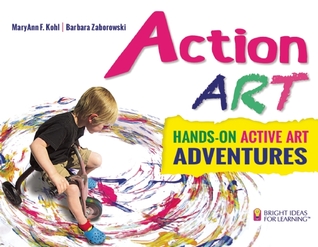 What could be more fun that creating art while being physically active? An upcoming book by MaryAnn Kohl and Barbara Zaboroski shows how to do just that in ways that encourage children to make choices and control art medium in active ways. I had a sneak preview of Action ART: Hands-on active art adventure and look forward to doing the activities where children get to manipulate materials and make changes, learning about material properties and their own abilities.
What could be more fun that creating art while being physically active? An upcoming book by MaryAnn Kohl and Barbara Zaboroski shows how to do just that in ways that encourage children to make choices and control art medium in active ways. I had a sneak preview of Action ART: Hands-on active art adventure and look forward to doing the activities where children get to manipulate materials and make changes, learning about material properties and their own abilities.
 Being active is one part of being healthy. Kindergarten teacher and blogger Gail Poulin voices an issue that concerns me too—how we can support children in making healthy food choices when family-packed and school lunches contain enough calorie dense sweet treats to satisfy children’s hunger before they get to the healthier choices of vegetables and healthy proteins?
Being active is one part of being healthy. Kindergarten teacher and blogger Gail Poulin voices an issue that concerns me too—how we can support children in making healthy food choices when family-packed and school lunches contain enough calorie dense sweet treats to satisfy children’s hunger before they get to the healthier choices of vegetables and healthy proteins?
Modeling the desired behavior makes the healthy choice visible. Teachers can talk about how much they enjoy the crunch of carrots or the flavor of whole grains. A lesson that involves families can support beginning steps towards making food choices that focus on whole grains and vegetable–foods that the USDA and the American Heart Association recommend.
The Early Sprouts curriculum has many choices for activities that include families. An entire year’s curriculum is designed to involve children and families in a seed-to-table experience, broadening their knowledge of and exposure to six target vegetables. They call on us to say if we “like” a food, or if we “don’t like it yet.” (I’ve adopted this practice in experiences with worms and insects–“I have touched a worm” and “I haven’t touched a worm yet.”)
I stand to write on the computer at home to make it easier for me to move, thanks to the advice of a physical therapist. There are many times when we move chairs out of the way so children can stand and move around to work at a table. What kinds of changes have you made to your program to support activity and healthy food choices?
 The November 2014 issue of Young Children, a journal of the National Association for the Education of Young Children, focuses on nutrition and fitness for all young children. In the article, “Preventing Childhood Obesity: Strategies to Help Preschoolers Develop Healthy Eating Habits,” Dr. Brent McBride and Dr. Dipti Dev urge us to help children recognize their own internal cues of hunger and fullness by asking “Are you full?” or saying, “You can have more if you are hungry.” This respects and supports children’s self-regulation of the food they need to fuel their bodies and increases the likelihood that children will make healthy eating decisions.
The November 2014 issue of Young Children, a journal of the National Association for the Education of Young Children, focuses on nutrition and fitness for all young children. In the article, “Preventing Childhood Obesity: Strategies to Help Preschoolers Develop Healthy Eating Habits,” Dr. Brent McBride and Dr. Dipti Dev urge us to help children recognize their own internal cues of hunger and fullness by asking “Are you full?” or saying, “You can have more if you are hungry.” This respects and supports children’s self-regulation of the food they need to fuel their bodies and increases the likelihood that children will make healthy eating decisions.
Do you have strategies for being active or eating healthy choices that you have adopted or practice in your early childhood program?
NSTA Web Seminars Bring the Experts to You
By Carole Hayward
Posted on 2014-11-13
NSTA knows not all teachers can travel, which is why our online programs bring NSTA experts and faculty directly to you. NSTA Web Seminars are free, live professional learning experiences that allow participants to interact with nationally acclaimed experts, NSTA Press authors, and scientists, engineers, and education specialists from NSTA partner organizations.
Free interactive online education is a great opportunity to enhance your understanding of content and pedagogy. Take advantage of the free online tools, including materials to strengthen your understanding of the Next Generation Science Standards (NGSS).
NSTA’s web seminars are hosted in the NSTA Learning Center and participants earn 100 Learning Center activity points and a certificate of participation for attending and completing the evaluation form at the end of the program.
- Register for Upcoming Web Seminars
With a dozen live web seminars through November and December, NSTA Learning Center is helping you schedule professional development time on your calendar. Get involved in the NGSS conversation, ask questions from presenters, and download all the free materials. - Interact with the presenter and participants via a chat window and interactive polls and slides.
- Meet and network with other educators from across the country and around the world.
- Explore the Archives
Can’t participate live? Hundreds of seminars have been archived and are available for viewing after the live event has occurred. The archive includes the capture of the live presentation—and it’s free to all!
Brew a cup of coffee, curl up with your laptop, and enjoy content from NASA, NOAA, NSF and so many other great partners. NSTA Web Seminars are a great way to access the treasure trove of NSTA materials.
Not a member of NSTA? Learn more about how to join.
Laura Berry of Cogberry Creative is our guest blogger for this series. Laura is a communications professional for the education community.
Prepping for a pre-service teacher
By Mary Bigelow
Posted on 2014-11-11
 I agreed to work with a student teacher next semester, and I’m looking forward to the experience. I teach three classes of biology and an AP class at the high school and two sections of middle school science. Should the student teacher take all of these preps, including the middle school one? In addition to classroom teaching, should the student teacher take on my other duties? What else do I need to know?
I agreed to work with a student teacher next semester, and I’m looking forward to the experience. I teach three classes of biology and an AP class at the high school and two sections of middle school science. Should the student teacher take all of these preps, including the middle school one? In addition to classroom teaching, should the student teacher take on my other duties? What else do I need to know?
P, California
Pre-service teachers can learn a lot in their content courses, methods courses, and classroom visits, but there is no substitute for real day-to-day teaching. It’s hard to let go of your own classes and have some one else take over, especially when he or she might make mistakes. You’ll find that you’re working just as hard as you did when you did not have a student teacher, but it’s a different kind of work (and a form of professional development).
Contact the college or university student teaching office or check the student teaching handbook to find out what duties the student teacher is to assume and any other suggested or required activities. Ask questions: What are the supervisor’s expectations for phasing the student teacher into your teaching schedule? What lesson plan format will the student teacher use? What are the student teacher’s content strengths and areas of certification? Is co-teaching an option for some sections? How and by whom will the student teacher be evaluated? What are the procedures if the student teacher is not the right fit for your school or classes? It would be great if you can meet the student teacher and supervisor prior to the first day to discuss and clarify these and other expectations and requirements
With the way the job market is, it might be good for your student teacher to have a variety of experiences, including some with younger students, assuming his certifications will include this level. I was assigned to a junior high situation as a student teacher and found that I really enjoyed the younger students. (I spent 17 subsequent years in the seventh grade!) Or he can decide that they’re not for him and focus a job search on high school. Even if he does not totally take over the middle school or AP classes, it still would give him some exposure to these courses.
In the real world, many teachers have multiple preps, so it would be helpful for your student teacher to understand how to coordinate planning and class activities. Perhaps co-teaching the middle school or AP class would be a possibility. It would also be important for him to have experiences with students who have special needs and to understand the requirements and documentation associated with Individual Education Plans.
I would also give your student teacher opportunities to observe other classes to see the variety of strategies teachers use and get ideas for his future classroom/lab. Even if it’s not required by the student teaching program, it can be eye-opening for him to video a class and analyze the lesson from the perspective of the teacher and the students.
He should also learn about the safety rules and procedures that are part of being a science teacher. Your student teacher should also develop an understanding of the Next Generation Science Standards and science, technology, engineering, and mathematics (STEM) topics, and the teacher evaluation practices in your state.
Part of the responsibility of teaching goes beyond the class schedule. You could consider asking your student teacher to
- Attend faculty meetings, department or committee meetings, curriculum workshops, inservice activities.
- Participate in your non-instructional duties (homeroom, hall duty, study halls, etc.).
- Assist you with managing lab materials and resources.
- Attend student events (plays, concerts, athletic contests).
- Attend a school board meeting.
- Learn about the requisition and budgeting process.
- Prepare an “emergency” lesson plan for a substitute to follow.
- Make a presentation at a department meeting on new technology or other skill that he has.
Set aside some time on a regular basis for you and the student teacher to sit down, go over the class events, and reflect on the student teacher’s progress.
Mentoring the next generation of teachers is an important part of the profession. Thank you for assuming this responsibility!
Photo: http://www.flickr.com/photos/jjlook/7152722/sizes/s/in/photostream/
 I agreed to work with a student teacher next semester, and I’m looking forward to the experience. I teach three classes of biology and an AP class at the high school and two sections of middle school science. Should the student teacher take all of these preps, including the middle school one? In addition to classroom teaching, should the student teacher take on my other duties? What else do I need to know?
I agreed to work with a student teacher next semester, and I’m looking forward to the experience. I teach three classes of biology and an AP class at the high school and two sections of middle school science. Should the student teacher take all of these preps, including the middle school one? In addition to classroom teaching, should the student teacher take on my other duties? What else do I need to know?
P, California
New from NSTA: Quick Reference Guides to the Next Generation Science Standards
By Lauren Jonas, NSTA Assistant Executive Director
Posted on 2014-11-10
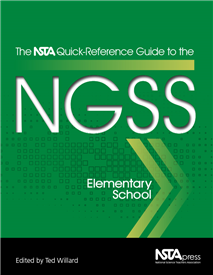 In focus groups, science teachers tell NSTA staff members that time is their biggest challenge. We hear that again and again, and we listen! Many science educators are excited about the Next Generation Science Standards (NGSS) and have begun to implement them in their schools and districts. We hear from many members of our network that, even in states where the standards have not been adopted, teachers still want to use them because of the innovative research underpinning them, and to use the practices. And they tell us they need resources that are quick and easy to access. So we are pleased to say that we have released a series of quick reference guides to the NGSS, and they’ve been edited by our in-house NGSS guru, Ted Willard!
In focus groups, science teachers tell NSTA staff members that time is their biggest challenge. We hear that again and again, and we listen! Many science educators are excited about the Next Generation Science Standards (NGSS) and have begun to implement them in their schools and districts. We hear from many members of our network that, even in states where the standards have not been adopted, teachers still want to use them because of the innovative research underpinning them, and to use the practices. And they tell us they need resources that are quick and easy to access. So we are pleased to say that we have released a series of quick reference guides to the NGSS, and they’ve been edited by our in-house NGSS guru, Ted Willard!
H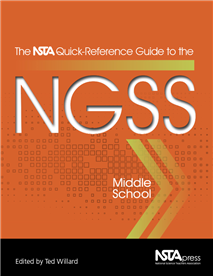 ere’s a link to each grade-specific version, and the description follows:
ere’s a link to each grade-specific version, and the description follows:
- The NSTA Quick-Reference Guide to the NGSS, Elementary School
- The NSTA Quick-Reference Guide to the NGSS, Middle School
- The NSTA Quick-Reference Guide to the NGSS, High School
- The NSTA Quick-Reference Guide to the NGSS, K–12
Since the release of the first draft of the Next Generation Science Standards (NGSS), NSTA has been at the forefront in promoting the standards and helping science educators become familiar with and learn to navigate this exciting but complex document. Later, when the final version was released and states began adopting the standards, NSTA started to develop resources that would assist educators with their implementation.
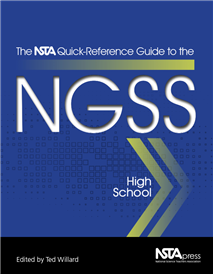 Along the way, NSTA learned that even the simplest of resources, like a one-page cheat sheet, can be extremely useful. Many of those tools are collected here, including:
Along the way, NSTA learned that even the simplest of resources, like a one-page cheat sheet, can be extremely useful. Many of those tools are collected here, including:
- a two-page “cheat sheet” that describes the practices, core ideas, and crosscutting concepts that make up the three dimensions described in A Framework for K–12 Science Education;
- an “Inside the Box” graphic that spells out all of the individual sections of text that appear on a page of the NGSS;
- a Venn diagram comparing the practices in NGSS, Common Core State Standards, Mathematics, and Common Core State Standards, English Language Arts; and
- matrices showing how the NGSS are organized by topic and disciplinary core idea.
This guide also provides the appropriate performance expectations; disciplinary core ideas; practices; crosscutting concepts; connections to engineering, technology, and applications of science; and connections to nature o f science. It is designed to be used with the NGSS.
f science. It is designed to be used with the NGSS.
The NSTA Quick-Reference Guides to the NGSS are also available in grade-specific versions—one each for elementary and high school—plus a comprehensive K–12 edition. The four Quick-Reference Guides are indispensable to science teachers at all levels, as well as to administrators, curriculum developers, and teacher educators.
Implementing the Next Generation Science Standards: How Your Classroom Is Framed Is as Important as What You Do in It
By Guest Blogger
Posted on 2014-11-10
As humans, we are driven to explore and explain our surroundings; we wonder about the things we see and try to figure out how and why they appear the way they do and what some of the underlying mechanisms might be that drive what we see in the world. At its core, science is a systematic and community-driven process by which humans make sense of the world around them by examining patterns and data from the world and developing models that can account for those patterns. Ultimately, it is the models we have of the world that allow us to create explanations for the things we see around us. This process whereby we examine, wonder, and seek to explain is a cyclic one and is at the core of the scientific enterprise.
In contrast, as teachers we are used to thinking about our classes as a series of discrete topics to teach. We consult textbooks, pacing guides, and standards documents to get the list of things to make sure we cover by the end of our grade level. We tend to think about each unit of instruction separately, and despite good intentions to weave things together, many of us have trouble making really substantive connections from one unit to the next. But, this conceptualization is not in line with how scientists themselves think about their disciplines. The writers of the Framework for K-12 Science Education have been very deliberate about how they portrayed the content of each discipline as a set of big, overarching, interconnected core ideas with just a few major components identified for each idea. Part of the promise—and the challenge—inherent in the vision portrayed in the Framework is for us as educators to move away from lists of discrete facts organized into separate units and toward a coherent set of ideas that can provide a foundation for further thought and exploration in the discipline. Indeed, the writers of the Framework and most science educators agree that it is impossible to cover all the scientific content that is relevant to modern science.
Instead, our ambitions as teachers of science need to be re-focused on developing deep and flexible thinkers with an understanding of how a relatively small number of truly core ideas support the broader scientific endeavor on an ongoing and generative basis. Students with encyclopedic but inert knowledge will not be prepared for the 21st century. Instead, the outcome of a quality science education that spans grade levels and develops in appropriate ways from early childhood through adolescence should be a cadre of students who can use their understanding of the core ideas of the discipline to make sense of the world and to further our collective understanding of it. Good science education is not an end unto itself, but a beginning.
Come with me for a walk through an imaginary school. Let’s tiptoe into a classroom and see what kids are doing. We open the door and slip into the back of the room. We see kids at tables working with clear bins of water, cups of hot water and food coloring. We ask the kids what they are trying to figure out. One girl pipes up and says, “We’re learning about convection currents. See, when you put the cup of hot water under the end of the bin here it makes that drop of food coloring swirl around.” Another student pipes up, “Yeah, see, the food coloring drop goes up once the area is heated. Heat rises, that’s convection.” Sounds pretty good right? Kids are working with stuff, watching how things work, and using science vocabulary. Seems cool, huh?
Now let’s go into the class next door. We sneak in the back and see they have the same set up at their lab tables. Let’s ask the same question: “Hey guys, what are you up to here? What are you trying to figure out?” This time a student says, “We’re trying to figure out how hot air balloons work.” “Oh yeah”, you say, “what do these tubs of water have to do with hot air balloons?” The students proceed to tell us that they are using the tubs, the food coloring, and the cups of hot water to see what happens when you heat up just one area of a fluid. A boy says, “see when we put this drop of food coloring on the bottom of the bin and then put our hot cup of water underneath, something starts to happen. The food coloring swirls around!” A girl adds, “yeah, so it’s kind of like the hot air balloon. You heat up one part of the water or the air or whatever and that part goes up. We want to know why that happens!”
So, what is the difference between these two classrooms and what does this have to do with the Next Generation Science Standards (NGSS) and the science and engineering practices? In the first classroom, the students are engaged in learning about a science idea, convection, whereas in the second classroom the kids are trying to figure out how some aspect of the world works. They are investigating, questioning, and modeling a phenomenon with the ultimate goal of developing an explanation for why hot air balloons go up when the air inside them is heated. In this second case the kids are engaged in the science practices and it is through that engagement that they will learn an important science concept. In the first classroom the kids may emerge with that same concept under their belts. Presumably at the end of these lessons both groups of kids should be able to define convection. However, in the first classroom that definition seems to be the end goal. In the classroom centered on a phenomenon, it is the start of something more. The kids recreate a convection current in their tubs and then ask, “why does that happen?” Understanding how differential heating of a fluid can cause movement is a fundamental idea to much of Earth Science. Here rather than positioning that idea as basically a term, convection, that needs to be given to students and experienced, the second teacher has created a rich problem space around it. The kids not only get to the basic idea of convection, but wonder why it happens, which can lead to further investigations of the nature of matter, density, and many, many applications of density currents in the natural world.
One way to characterize the difference here is around framing. The term framing is one we use in our everyday life quite a bit. Listen for it over the next few days. We say things like “the media framed the debate around…” or “she framed her participation in the discussion by…” The way I am using it here is consistent with Scherr and Hammer’s description in their 2009 paper called Student Behavior and Epistemological Framing: Examples from Collaborative Active Learning Activities in Physics published in a journal called Cognition and Instruction. In that paper they say “a student may frame a learning activity as an opportunity for sense-making or as an assignment to fill out a worksheet. The student’s understanding of the nature of the activity affects what she notices, what knowledge she accesses, and how she thinks to act.” For any activity in a science class we should be asking: How are the kids framing their activity, what do they think they are up to? In the first class they’ve framed the task as demonstrating convection. The second class they’ve framed it as investigating a phenomenon.
The more I work with teachers on shifting their practice to better align with the NGSS, the more I realize the importance of framing. The material activity in the two classrooms was exactly the same; kids were creating convection currents in tubs of water. However, how those activities were set up and what the kids thought they were doing was completely different. One was confirmatory; the other was exploratory. So even though the material activity was the same, the intellectual work was quite different. In order to be fully engaged in the practices, it’s simply not enough to merely learn about the science idea, however creative and hands on the task may be. To engage in the practices, really participate in them, a student has to frame the task as an exploration. The intellectual work of the classroom has to be centered on figuring out how or why something happens.
So, as you begin to shift your classroom towards the vision of the Framework and the NGSS I ask you to pay attention to this issue of framing. What have you done to set up the tasks in your classroom? What do the students think they are doing and why? How can you create the conditions for students to participate in the practices?
Today’s Guest Blogger
 Cynthia Passmore, Ph.D., is an Associate Professor specializing in science education in the University of California, Davis School of Education. She did her doctoral work at the University of Wisconsin, Madison and prior to that she was a high school science teacher. Her research focuses on the role of models and modeling in student learning, curriculum design and teacher professional development. She investigates model-based reasoning in a range of contexts and is particularly interested in understanding how the design of learning environments interacts with students’ reasoning practices. She has been the principal investigator of several large grants and has co-authored several papers on modeling in science education that have been published in journals such as Science & Education, The International Journal of Science Education and School Science and Mathematics; e-mail her at cpassmore@ucdavis.edu.
Cynthia Passmore, Ph.D., is an Associate Professor specializing in science education in the University of California, Davis School of Education. She did her doctoral work at the University of Wisconsin, Madison and prior to that she was a high school science teacher. Her research focuses on the role of models and modeling in student learning, curriculum design and teacher professional development. She investigates model-based reasoning in a range of contexts and is particularly interested in understanding how the design of learning environments interacts with students’ reasoning practices. She has been the principal investigator of several large grants and has co-authored several papers on modeling in science education that have been published in journals such as Science & Education, The International Journal of Science Education and School Science and Mathematics; e-mail her at cpassmore@ucdavis.edu.
The mission of NSTA is to promote excellence and innovation in science teaching and learning for all.
Follow NSTA
| |
|
|
|
As humans, we are driven to explore and explain our surroundings; we wonder about the things we see and try to figure out how and why they appear the way they do and what some of the underlying mechanisms might be that drive what we see in the world. At its core, science is a systematic and community-driven process by which humans make sense of the world around them by examining patterns and data from the world and developing models that can account for those patterns. Ultimately, it is the models we have of the world that allow us to create explanations for the things we see around us.
Patterns: a crosscutting concept
By Peggy Ashbrook
Posted on 2014-11-08
Children notice patterns in nature in small moments as they play in natural areas and find a new kind of leaf, or suddenly realize one morning that they are leaving for school before the sun comes up. Did that happen recently with any of your children with the daylight savings time change? Teachers can build on these observations by helping children record their observations and track small changes, and then holding discussions or conversations reflecting on these records. One of the crosscutting concepts described by the Next Generation Science Standards, Patterns, is central to many science investigations at all ages.
 The crosscutting concepts, “Patterns”, “Scale, proportion, and quantity” and “Structure and function” are evident in children’s play as they choose large leaves to serve as “plates” and smaller leaves or flowers as the “food” for their housekeeping scenario. They repeat the patterns they see in the layout of food on plates, and notice the scale of the food pieces compared to the size of the plates and the structure of the stiff large plates and the easy-to-tear smaller leaves.
The crosscutting concepts, “Patterns”, “Scale, proportion, and quantity” and “Structure and function” are evident in children’s play as they choose large leaves to serve as “plates” and smaller leaves or flowers as the “food” for their housekeeping scenario. They repeat the patterns they see in the layout of food on plates, and notice the scale of the food pieces compared to the size of the plates and the structure of the stiff large plates and the easy-to-tear smaller leaves.
In the October 2014 issue of Science and Children, I wrote an Early Years column about children examining plant leaves on multiple occasions over time, and discovering patterns in shape and other attributes.
If you have already investigated leaf shapes in your program, your children might be ready to become citizen scientists and observe the “leafing-out” of a favorite plant. Young children and their teachers can participate in Project BudBurst. This is an on-going investigation into when a plant bud begins to open–not very exciting if you only check once but when children check a plant weekly, and then document their observations with drawings or photos, the gradual change becomes exciting. And during the data gathering period, they can celebrate the day when a leaf is “as big as a fingernail”, or even their hand.
Some favorite trade books that call attention to leaves and patterns are:
Leaves
- A Tree Is Nice by Janice May Udry,
- Maples in the Mist. by Minfong Ho,
- A Log’s Life by Wendy Pfeffer,
- Autumn Leaves by Ken Robbins,
- The wonderful tree; a story of the seasons by Adelaide Hall and Gyorgy Lehoczky,
- I Am a Leaf by Jean Marzollo
- Trees, Leaves & Bark by Diane Burns
- Red Leaf Yellow Leaf by Lois Elhert
- A Tree is Growing by Arthur Dorros
What other books that you use in your program can you share with us?
Patterns
- Echoes for the Eye by Barbara Juster Esbensen,
- Insect by Laurence Mound,
- Children’s Guide to Birds by Jinny Johnson,
- Fish by Steve Parker,
- The Book of Sea Shells by Michael H. Bevans,
- Pattern (Math Counts) by Henry Pluckrose
The Children’s Museum of New Hampshire suggests using songs and books to teach the concept of patterns to young children.
http://www.childrens-museum.org/cmnh2010/about/content.aspx?id=398
What books or other resources about patterns can you share with us?
Children notice patterns in nature in small moments as they play in natural areas and find a new kind of leaf, or suddenly realize one morning that they are leaving for school before the sun comes up. Did that happen recently with any of your children with the daylight savings time change? Teachers can build on these observations by helping children record their observations and track small changes, and then holding discussions or conversations reflecting on these records.
Hesitate to Participate? Part 2
By Mary Bigelow
Posted on 2014-11-03
 In a previous blog, a teacher posed a question about getting her students to participate in discussions.
In a previous blog, a teacher posed a question about getting her students to participate in discussions.
She shared her experiences in trying the strategies suggested by our colleagues and her reflections on the results:
I have already implemented pair-share strategies, and students varied in their willingness to talk to each other. I found at this point that the girls were quieter when paired with the boys. I must say that the boys are not aggressive or demeaning, and really supportive of other students, so …direct intimidation was not evident.
I had one girl willing to participate at the beginning, but she tended to back off after a period of time. I got the sense she was feeling like others are not speaking up, so perhaps she shouldn’t either. There was another girl who, although very quiet, [became] willing to talk.
I tried to divide the room for a week between boys and girls so that the pair-share could be done with same gender. This was only mildly successful. But it gave me the opportunity, to meet with the girls to encourage them and listen to the discussion. I found they were still very quiet and seemed to be “afraid” to be wrong and did not want to risk speaking, even with their female peers. But it was better. After pair-share, I would open it up to allow the whole class to talk and when I asked for volunteers to share a certain answer based on their pair-share, all the boys hand went up and the girls just looked across the room and kept their hands down.
I did ask one student, outside of class, if she might be willing to try to volunteer more, as when I did call on her, she usually had something to say. I told her that I need some role models, and I thought she could help. The next day she did volunteer. I am also going to speak to the girl who started and then stopped to encourage her directly.
I am now planning on changing seats again, based on personalities, and strengths to mix them back up and continue to try. I plan on starting with the suggested strategy about a small group in which students each have to take turns talking, then summarizing what the next person said, then sharing more and then the whole group decides to see who will share with the class. I will try this twice during the class, and a different person has to do the sharing part.
The hard part is I want to be able to get a pulse on their understanding as we go along, but with half the room not willing to share their answers, I never know where they stand. I do use the thumbs up and thumbs down technique to get some answers and this helps a little, but I still see the girls look toward the boys to confirm their decision of the “right” answer.
So the pair-shares have been going a bit better, but there still is hesitation. I have started calling on students who did not raise their hands (I told them ahead of time) during pair share, so they could be sure they had something to say. This helped a bit. Boosting self-esteem is a piece I am going to work on, too. I think this is going to be a yearlong project. I need to break through layers of issues, but I will keep trying.
L. is using a process called action research,* a systematic approach to address the situation in her classroom:
- Identify a situation or problem
- Gather information to identify possible actions or solutions (student background, more on the context of the situation, suggestions from the literature, or recommendations from colleagues)
- Take action based on the information
- Collect and analyze data
- Reflect on the results
- Develop an action plan to address the situation or identify a need for further research
For more on the action research process:
- What is Action Research? New Mexico State University
- Action Research
- Action Research for Teachers
There was a suggestion for L. to try “Round Robin Journaling.” The April/May 2014 issue of Science & Children had the article Assessments in the Arguments with a description of this strategy.)
For more on class participation:
- Encouraging Class Participation—How can you provide opportunities for all students to participate in a discussion?
- Participation Rubric—What do we mean by “participation?”
- Gallery Walks—How can they be used for discussion and feedback?
 In a previous blog, a teacher posed a question about getting her students to participate in discussions.
In a previous blog, a teacher posed a question about getting her students to participate in discussions.
She shared her experiences in trying the strategies suggested by our colleagues and her reflections on the results:
Legislative Update
K-12 Primer on the Midterm Elections and Everybody’s Talking about Testing
By Jodi Peterson
Posted on 2014-11-03
There is plenty of discussion this week on what’s ahead for education and science as Americans head to the polls on November 4, and the testing/accountability issue is really moving to the front burner as major players in education—including President Obama—weigh in on the issue.
But first, take a look at Education Week’s election guide, a great primer for K–12 political junkies interested in the key races to watch in the U.S. Senate, the U.S. House of Representatives, and the key gubernatorial races. The primer also tracks key education ballot measures in the states.
ScienceInsider is running an After Election 2014 series on issues of concern to the science community. This story on the American COMPETES bill nicely sums up the political divide on this legislation over the last few years.
Earlier ScienceInsider installments (featured in a previous issue of NSTA Express) focused on the federal government’s attempts to improve STEM education. Writes reporter Jeff Mervis, “The last 2 years have provided a vivid reminder that improving U.S. science education will depend at least as much on grassroots efforts as on the federal government. The administration’s biggest gambit—a plan to restructure the $3 billion federal investment in STEM (science, technology, engineering, and mathematics) education—went down in flames after lawmakers from both parties and community leaders denounced it as unwise and poorly designed.”
Testing and accountability are also hot in Washington, D.C. right now. On October 15, the Council of Chief State School Officers and the Council of Great City Schools announced a joint effort to improve student testing and released a two-page Commitments on High-Quality Assessments.
Education Secretary Arne Duncan’s blog post earlier this summer, which stated “testing and test preparation takes up too much time,” seemed to raise eyebrows since the Department of Education has been a stalwart champion of testing/accountability/teacher evaluations. Last week Education Week reporter/blogger Alyson Klein reported that “President Barack Obama appears to be behind his administration’s recent rhetorical push on the need to reconsider the number of tests students take, sources say. And the president’s new thinking on tests would seem to put U.S. Secretary of Education Arne Duncan in a pretty awkward position.” Read why.
A few days later a broad-based group of 17 organizations—including the Alliance for Quality Education, the American Federation of Teachers, the National Association of Secondary School Principals, the National Education Association, and the National School Boards Association—announced A New Social Compact for American Education, promising “a groundbreaking rethinking of accountability that replaces the current paradigm of ‘test and punish’ with a focus on what is needed to support and improve teaching and learning.”
On Oct. 29, Education Week again blogged that big suburban district leaders are now favoring different testing models for NCLB waivers, calling for options for districts such as grade-span testing at key points, or testing that just samples certain students. The group called for fewer and better local assessments, and less focus on the state summative tests.
Capitol Hill is also on top of the testing issue. Rep. Steve Israel (D-NY) introduced the TEST Act, a bill that would significantly change the K-12 testing and accountability regime and would eliminate the federal requirement for science testing. This bill has bipartisan support and garnered significant attention in the press, along with a similar bill introduced by Rep. Chris Gibson (D-NY) and Rep. Kyrsten Sinema (D-AZ), which has the support of the NEA.
Stay tuned.
Jodi Peterson is NSTA’s Assistant Executive Director, Communications, Legislative, and Public Affairs; and Chair of the STEM Education Coalition. She can be reached at via e-mail at jpeterson@nsta.org or Twitter @STEMedadvocate.
The mission of NSTA is to promote excellence and innovation in science teaching and learning for all.
Follow NSTA
There is plenty of discussion this week on what’s ahead for education and science as Americans head to the polls on November 4, and the testing/accountability issue is really moving to the front burner as major players in education—including President Obama—weigh in on the issue.




